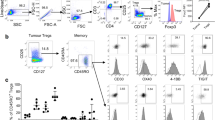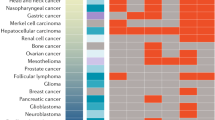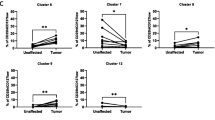Abstract
Analysis of tumour-infiltrating T cells in colorectal cancer can predict disease-free survival. The Immunoscore, obtained by quantifying tumour-infiltrating CD3+ and CD8+ T cells, may improve current staging. Effector regulatory T cells are a potently suppressive subset in mice and, while present in human colorectal cancer, their role in patient outcome is unknown. Immunofluorescence was used to analyse immune cell infiltrates in patients with early (stage II) colorectal cancer with (n = 13) and without (n = 19) recurrent disease. CD3 and CD8 were used for the Immunoscore; FOXP3, BLIMP-1 and CD3 to identify effector regulatory T cells. Patients with high Immunoscores had increased disease-free survival compared to patients with low Immunoscores (Log-rank test p < 0.01). Prediction of outcome was further improved by stratifying patients with a low Immunoscore according to CD3+FOXP3+BLIMP-1+ cell infiltration at the invasive margin. Patients with a low Immunoscore and high infiltrate of CD3+FOXP3+BLIMP-1+ cells tended to have better disease-free survival than patients with low Immunoscore and low infiltrate of CD3+FOXP3+BLIMP-1+ cells. Patients with a high Immunoscore had better disease-free survival than patients with a low Immunoscore and low infiltrate of CD3+ FOXP3+ BLIMP-1+ cells (Log-rank test p < 0.001). These results indicate that tumour infiltration with effector regulatory T cells improves the prognostic value of the Immunoscore and implies that these cells may play a role in colorectal cancer patient outcome.




Similar content being viewed by others
Abbreviations
- AJCC:
-
American Joint Committee on Cancer
- BLIMP-1:
-
B lymphocyte-induced maturation protein-1
- CRC:
-
Colorectal cancer
- FFPE:
-
Formalin-fixed, paraffin-embedded
- HPF:
-
High power field
- ICC:
-
Intraclass correlation coefficient
- IRIISS:
-
Independent Research Institute Infrastructure Support Scheme
- IS:
-
Immunoscore
- NHMRC:
-
National Health and Medical Research Council
- Treg:
-
Regulatory T cell
References
Ferlay J, Soerjomataram I, Dikshit R, Eser S, Mathers C, Rebelo M et al (2015) Cancer incidence and mortality worldwide: sources, methods and major patterns in GLOBOCAN 2012. Int J Cancer 136(5):E359–E386. doi:10.1002/ijc.29210
Quasar Collaborative G, Gray R, Barnwell J, McConkey C, Hills RK, Williams NS et al (2007) Adjuvant chemotherapy versus observation in patients with colorectal cancer: a randomised study. Lancet 370(9604):2020–2029. doi:10.1016/S0140-6736(07)61866-2
Benson AB 3rd, Schrag D, Somerfield MR, Cohen AM, Figueredo AT, Flynn PJ et al (2004) American Society of Clinical Oncology recommendations on adjuvant chemotherapy for stage II colon cancer. J Clin Oncol 22(16):3408–3419. doi:10.1200/JCO.2004.05.063
Jemal A, Siegel R, Ward E, Murray T, Xu J, Smigal C et al (2006) Cancer statistics, 2006. CA Cancer J Clin 56(2):106–130
Mlecnik B, Tosolini M, Kirilovsky A, Berger A, Bindea G, Meatchi T et al (2011) Histopathologic-based prognostic factors of colorectal cancers are associated with the state of the local immune reaction. J Clin Oncol 29(6):610–618. doi:10.1200/JCO.2010.30.5425
Mlecnik B, Bindea G, Angell HK, Maby P, Angelova M, Tougeron D et al (2016) Integrative analyses of colorectal cancer show Immunoscore is a stronger predictor of patient survival than microsatellite instability. Immunity 44(3):698–711. doi:10.1016/j.immuni.2016.02.025
Galon J, Costes A, Sanchez-Cabo F, Kirilovsky A, Mlecnik B, Lagorce-Pages C et al (2006) Type, density, and location of immune cells within human colorectal tumors predict clinical outcome. Science 313(5795):1960–1964. doi:10.1126/science.1129139
Galon J, Mlecnik B, Bindea G, Angell HK, Berger A, Lagorce C et al (2014) Towards the introduction of the ‘Immunoscore’ in the classification of malignant tumours. J Pathol 232(2):199–209. doi:10.1002/path.4287
Galon J, Pages F, Marincola FM, Angell HK, Thurin M, Lugli A et al (2012) Cancer classification using the Immunoscore: a worldwide task force. J Transl Med 10:205. doi:10.1186/1479-5876-10-205
Hori S (2014) Lineage stability and phenotypic plasticity of Foxp3(+) regulatory T cells. Immunol Rev 259(1):159–172. doi:10.1111/imr.12175
Wang J, Ioan-Facsinay A, van der Voort EI, Huizinga TW, Toes RE (2007) Transient expression of FOXP3 in human activated nonregulatory CD4+ T cells. Eur J Immunol 37(1):129–138. doi:10.1002/eji.200636435
Cretney E, Xin A, Shi W, Minnich M, Masson F, Miasari M et al (2011) The transcription factors Blimp-1 and IRF4 jointly control the differentiation and function of effector regulatory T cells. Nat Immunol 12(4):304–311. doi:10.1038/ni.2006
Nutt SL, Fairfax KA, Kallies A (2007) BLIMP1 guides the fate of effector B and T cells. Nat Rev Immunol 7(12):923–927. doi:10.1038/nri2204
Teh PP, Vasanthakumar A, Kallies A (2015) Development and function of effector regulatory T cells. Prog Mol Biol Transl Sci 136:155–174. doi:10.1016/bs.pmbts.2015.08.005
Montes de Oca M, Kumar R, de Labastida Rivera F, Amante FH, Sheel M, Faleiro RJ et al (2016) Blimp-1-dependent IL-10 production by Tr1 cells regulates TNF-mediated tissue pathology. PLoS Pathog 12(1):e1005398. doi:10.1371/journal.ppat.1005398
Cretney E, Kallies A, Nutt SL (2013) Differentiation and function of Foxp3(+) effector regulatory T cells. Trends Immunol 34(2):74–80. doi:10.1016/j.it.2012.11.002
Santner-Nanan B, Berberich-Siebelt F, Xiao Z, Poser N, Sennefelder H, Rauthe S et al. (2006) Blimp-1 is expressed in human and mouse T cell subsets and leads to loss of IL-2 production and to defective proliferation. Signal Transduct 6(4):268–279. doi:10.1002/sita.200500062
Girardin A, McCall J, Black MA, Edwards F, Phillips V, Taylor ES et al (2013) Inflammatory and regulatory T cells contribute to a unique immune microenvironment in tumor tissue of colorectal cancer patients. Int J Cancer 132(8):1842–1850. doi:10.1002/ijc.27855
Miyara M, Yoshioka Y, Kitoh A, Shima T, Wing K, Niwa A et al (2009) Functional delineation and differentiation dynamics of human CD4+ T cells expressing the FoxP3 transcription factor. Immunity 30(6):899–911. doi:10.1016/j.immuni.2009.03.019
Anitei MG, Zeitoun G, Mlecnik B, Marliot F, Haicheur N, Todosi AM et al (2014) Prognostic and predictive values of the immunoscore in patients with rectal cancer. Clin Cancer Res 20(7):1891–1899. doi:10.1158/1078-0432.CCR-13-2830
Richards CH, Roxburgh CS, Powell AG, Foulis AK, Horgan PG, McMillan DC (2014) The clinical utility of the local inflammatory response in colorectal cancer. Eur J Cancer 50(2):309–319. doi:10.1016/j.ejca.2013.09.008
Ling A, Edin S, Wikberg ML, Oberg A, Palmqvist R (2014) The intratumoural subsite and relation of CD8(+) and FOXP3(+) T lymphocytes in colorectal cancer provide important prognostic clues. Br J Cancer 110(10):2551–2559. doi:10.1038/bjc.2014.161
Ladoire S, Martin F, Ghiringhelli F (2011) Prognostic role of FOXP3 + regulatory T cells infiltrating human carcinomas: the paradox of colorectal cancer. Cancer Immunol Immunother 60(7):909–918. doi:10.1007/s00262-011-1046-y
Allan SE, Crome SQ, Crellin NK, Passerini L, Steiner TS, Bacchetta R et al (2007) Activation-induced FOXP3 in human T effector cells does not suppress proliferation or cytokine production. Int Immunol 19(4):345–354. doi:10.1093/intimm/dxm014
Hovhannisyan Z, Treatman J, Littman DR, Mayer L (2011) Characterization of interleukin-17-producing regulatory T cells in inflamed intestinal mucosa from patients with inflammatory bowel diseases. Gastroenterology 140(3):957–965. doi:10.1053/j.gastro.2010.12.002
Pages F, Kirilovsky A, Mlecnik B, Asslaber M, Tosolini M, Bindea G et al (2009) In situ cytotoxic and memory T cells predict outcome in patients with early-stage colorectal cancer. J Clin Oncol 27(35):5944–5951. doi:10.1200/JCO.2008.19.6147
Mumm JB, Oft M (2013) Pegylated IL-10 induces cancer immunity: the surprising role of IL-10 as a potent inducer of IFN-gamma-mediated CD8(+) T cell cytotoxicity. Bioessays 35(7):623–631. doi:10.1002/bies.201300004
Norton SE, Ward-Hartstonge KA, Taylor ES, Kemp RA (2015) Immune cell interplay in colorectal cancer prognosis. World J Gastrointest Oncol 7(10):221–232. doi:10.4251/wjgo.v7.i10.221
Erdman SE, Poutahidis T (2010) Roles for inflammation and regulatory T cells in colon cancer. Toxicol Pathol 38(1):76–87. doi:10.1177/0192623309354110
Blatner NR, Bonertz A, Beckhove P, Cheon EC, Krantz SB, Strouch M et al (2010) In colorectal cancer mast cells contribute to systemic regulatory T-cell dysfunction. Proc Natl Acad Sci USA 107(14):6430–6435. doi:10.1073/pnas.0913683107
Peduzzi P, Concato J, Kemper E, Holford TR, Feinstein AR (1996) A simulation study of the number of events per variable in logistic regression analysis. J Clin Epidemiol 49(12):1373–1379
Acknowledgements
We wish to thank all patients who participated in this study. In addition, we thank Tania Slatter and Tim Hodgson for pathology support and Mandy Fisher and the Histology Unit of Otago University for sample processing. We thank Andrew Gray, Mik Black and Josie Athens for statistical advice and Edward Taylor for establishing laboratory protocols. Thank you to Stephen L Nutt and Lynn M Corcoran (The Walter and Eliza Hall Institute of Medical Research) for providing the BLIMP-1 antibody.
This study was funded by the Genesis Oncology Trust and Lotteries Health New Zealand. Kirsten Ward-Hartstonge was supported by the Todd Foundation for Excellence, a Brenda Shore Award for Women and a PhD scholarship from Lotteries Health New Zealand. Erika Cretney was supported by a National Health and Medical Research Council (NHMRC) Fellowship and project grant #1047313. This work was made possible through Victorian State Government Operational Infrastructure Support and Australian Government NHMRC IRIIS. Adam Girardin received travel support for techniques from the Maurice and Phyllis Paykel Trust.
Author information
Authors and Affiliations
Corresponding author
Ethics declarations
Conflict of interest
The authors declare that no conflict of interest exists.
Electronic supplementary material
Below is the link to the electronic supplementary material.
Rights and permissions
About this article
Cite this article
Ward-Hartstonge, K.A., McCall, J.L., McCulloch, T.R. et al. Inclusion of BLIMP-1+ effector regulatory T cells improves the Immunoscore in a cohort of New Zealand colorectal cancer patients: a pilot study. Cancer Immunol Immunother 66, 515–522 (2017). https://doi.org/10.1007/s00262-016-1951-1
Received:
Accepted:
Published:
Issue Date:
DOI: https://doi.org/10.1007/s00262-016-1951-1




